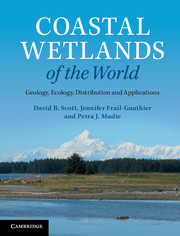Book contents
- Frontmatter
- Contents
- Preface
- List of acronyms and abbreviations
- 1 Introduction: what is covered in this coastal wetlands book?
- 2 Physical aspects: geological, oceanic and climatic conditions
- 3 Zonations and plants: development, stressors and adaptations
- 4 Animals in coastal wetlands: zonation, adaptations and energy flow
- 5 Human intervention causing coastal problems
- 6 Coastal wetlands worldwide: climatic zonation, ecosystems and biogeography
- 7 Examples of North American salt marshes and coastal wetlands
- 8 Examples of South American coastal wetlands
- 9 Africa: selected marsh and mangrove areas
- 10 Europe and Asia: a view of what remains
- 11 Australasia: wetlands of Australia and New Zealand
- 12 Applications in geological monitoring: paleoseismology and paleoclimatology
- 13 Applications in conservation of plant biodiversity and agriculture
- 14 Using mesocosms as a way to study coastal wetlands
- 15 Conclusions and future directions
- References
- Index
- Plate section
3 - Zonations and plants: development, stressors and adaptations
Published online by Cambridge University Press: 05 July 2014
- Frontmatter
- Contents
- Preface
- List of acronyms and abbreviations
- 1 Introduction: what is covered in this coastal wetlands book?
- 2 Physical aspects: geological, oceanic and climatic conditions
- 3 Zonations and plants: development, stressors and adaptations
- 4 Animals in coastal wetlands: zonation, adaptations and energy flow
- 5 Human intervention causing coastal problems
- 6 Coastal wetlands worldwide: climatic zonation, ecosystems and biogeography
- 7 Examples of North American salt marshes and coastal wetlands
- 8 Examples of South American coastal wetlands
- 9 Africa: selected marsh and mangrove areas
- 10 Europe and Asia: a view of what remains
- 11 Australasia: wetlands of Australia and New Zealand
- 12 Applications in geological monitoring: paleoseismology and paleoclimatology
- 13 Applications in conservation of plant biodiversity and agriculture
- 14 Using mesocosms as a way to study coastal wetlands
- 15 Conclusions and future directions
- References
- Index
- Plate section
Summary
Key points
Salt marshes and mangroves grow seawards and upwards by sediment accretion resulting from sediment binding by surface algae and roots of pioneer plants; tides transport sediment, nutrients and oxygen to marsh plants twice a day or less, depending on the elevation above MLW; marsh vegetation traps suspended sediment and further raises the marsh; soil salinity stressors increase in the high marsh where there is less regular influence of tidal flow; waterlogging, low oxygen and sediment mobility are the main stressors in low marshes and mudflats; elevational microhabitats have different floras and faunas according to their physiological tolerances of salinity and soil oxygen, resulting in a succession of plant communities; plant adaptations are both structural (e.g. salt glands, creeping roots with air passages, or platform roots with ‘lungs’) and internal (C3, C4 and CAM metabolism) to optimize photosynthesis when alternately submerged and dry; coastal wetlands are thus very productive carbon storage systems; pollen of the different plants marking the marsh zones provides an archive of changes in marsh zonation, salinity and climate over time; pollen of exotic species is used to trace changes in sediment accretion associated with anthropogenic impacts.
Sediment stabilization and salt marsh development
Algae and halophytic grasses or succulents are the bioengineers in the formation and maturation of a coastal wetland, which is also tightly linked to the baseline coastal geomorphology. Tidal flats gain elevation relative to MSL by sediment accretion of the mudflats which decreases the rate and duration of tidal flooding and allows pioneer halophytes to colonize the periodically exposed surface. Mud from rivers and streams also increases sediment deposition by fall-out of suspended sediment where freshwater mixes with seawater over the low-gradient mudflat. Potential colonizing plants arrive on the bare surface as either seeds, propagules (= germinated seedlings) or portions of rhizomes. When conditions are right, germination and establishment of pioneer halophytes begins, and the marsh starts to grow. This colonization is also aided by mats of diatoms and filamentous blue-green algae that bind together small silt and clay particles on the mudflat surface (Figure 3.1).
- Type
- Chapter
- Information
- Coastal Wetlands of the WorldGeology, Ecology, Distribution and Applications, pp. 17 - 29Publisher: Cambridge University PressPrint publication year: 2014



